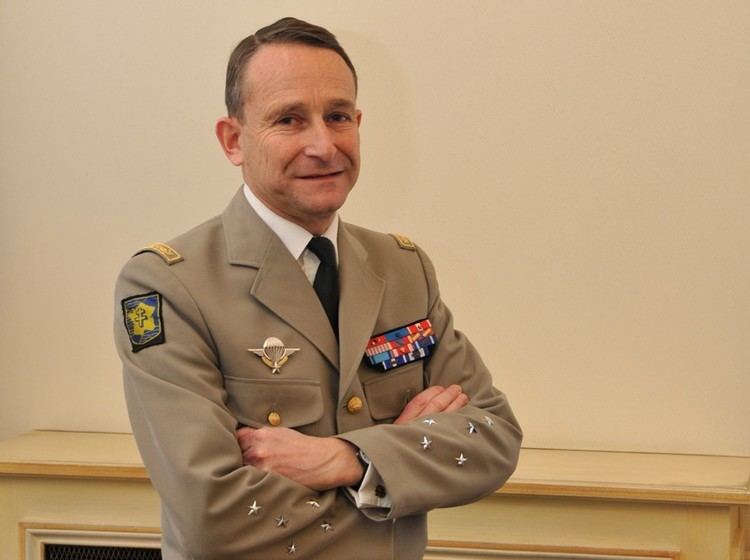The Chef d'État-Major des Armées (French: Chef d'État-Major des Armées) (acronym: C.E.M.A) is the Chief of defence of France and leading senior military officer responsible for usage of the French Armed Forces, ensuring the commandment of all military operations (under reserve of the particular dispositions relative to nuclear deterrence).
C.E.M.A is currently held by Général Chef d'État-Major des Armées.
The Chef d'État-Major des Armées (French: CEMA) assists the Ministre de la Défense in his capacity attributions to make use of the various required forces. C.E.M.A, in virtue of decree dispositions of July 15, 2009, under the authority of the President of France, the French government, and under the reserve of the particular dispositions relative to nuclear deterrence, is responsible for the use of forces and commandment of all military operations. CEMA is the military counselar of the government.
C.E.M.A has authority over the:
Chief of Staff of the French Army (French: Chef d'État-Major de l'Armée de Terre, CEMAT)
Chief of Staff of the French Air Force (French: Chef d'État-Major de l'Armée de l'Air, CEMAA)
Chief of Staff of the French Navy (French: Chef d'État-Major de la Marine, CEMM)
C.E.M.A responsibilities consist of:
The inter-arm organizations and the general organization of the armed forces
The expression of the need in material of human resources of the armed forces, the inter-arm institutions, and the definition of the ensemble format of the armed forces.
The preparation and condition assignments of recruiting in the armed forces
Support of the armed forces ( CEMA determines the general organizations and objectives. CEMA assures the operational maintenance in condition of all equipments. CEMA determines the inter-arm needs of various material infrastructures and that of the armed forces while verifying status of operability)
The renseignement of military interest. CEMA ensures the general research direction and exploitation of the renseignement militaire and has authority on the direction du renseignement militaire
International military relations
Responsibilities and authorities
C.E.M.A is responsible for :
Conduct of operations : plans of use, general articulation of forces, distribution of operational means between theatre commanders (over whom he has full authority)
Forces preparation : CEMA is in check of forces aptitude in missions completion and has a permanent right of inspection over these forces;
Future Preparation : planning and programming of military capacities. Oversees in effect of coherence in means of the armed forces and participates to the preparation and various executions of associated military and defence budgets.
Inter-arm organization: Oversees the coherence of the armed forces organization
Military relations with foreign militaries: CEMA directs French foreign military missions in foreign theatres, organizes the participation of the armed forces in regards to military cooperations, following international mandated negotiations and represents France at the varuous military committees of international organizations.
Directly under the CEMA authority are :
Les Chefs d’état-major de l'Armée de terre, de La Marine et de l’Armée de l’Air
l'État-Major des armées (EMA)
The Inspection of the Armed Forces (IDA)
Superior commanders in the collective and overseas territorial departments and the commanders of the French forces in foreign areas (COMSUP and COMFOR), the officiers généraux of the zones de défense et de sécurité (OGZDS) and the délégués militaires départementaux (DMD)
Inter-arm institutions:
Direction du renseignement militaire (DRM) – Directorate of Military Intelligence
French Special Operations Command (French: Commandement des Opérations Spéciales (COS))
état-major interarmées de force et d'entraînement (EMIA-FE)
Direction centrale du service de santé des armées (DCSSA) – Military Medical Services
Direction centrale du service des essences des armées (DCSEA) – Military Fuel Services
Direction interarmées des réseaux d'infrastructures et des systèmes d'information (DIRISI)– Inter-arm infrastructure and Information Systems Directorate
Direction centrale du service du commissariat des armées - DCSCA, created January 1 2010
Service interarmées des munitions, created March 25 2011
Enseignement militaire supérieur.
The Chef d'État-Major des Armées (CEMA) is assisted by a Major General of the Armed Forces (French: Major Général des Armées), a senior ranked officer of the French Armed Forces.
Général de division Jean-Louis Borel: 1874–1875
Général de division Henri Gresley: 1875–1877
Général de division Marie-Joseph François de Miribel: 1878–1879
Général de division Léopold Davout: 1879–1880
Général de division Omer Arsène Blot: 1880–1881
Général de division Achille Ernest Vuillemot: 1882–1883
Général de division Amédée de Cools: 1884–1885
Général de division Savin de Larclause: 1886–1887
Général de division Charles Haillot: 1888–1890
Général de division Joseph de Miribel: 1891–1893
Général de division Raoul Le Mouton de Boisdeffre: 1894–1898
Général de division Paul Marie Brault: 1899–1901
Général de division Jean Pendezec: 1901–1905
Général de division Jean Brun (général): 1906–1909
Général de division Édouard Laffon de Ladebat: 1910–1911
Général de division Auguste Dubail: 1911
Général de division Joseph Joffre: 1912–1914
Commandant en chef des armées françaises (1915–1918)
While non official, the term Generalissimo or « French: Généralissime » was employed since 1914 to designate the individual who in reality was « Commandant en Chef des Armées du Nord et du Nord-Est » (English: Commander-in-Chief of the armies of the North and North-East). The term would be made official in 1915 when Joffre was also given command over the Salonika front (a degree of authority not enjoyed by his successors). The rank and post was successively occupied by three generals during World War I: Joseph Joffre, who occupied the rank and functions from August 1914 without bearing the official title, then Robert Nivelle and Philippe Pétain.
Général Ferdinand Foch was the Assistant Commander-in-Chief of the Northern Zone under Joseph Joffre in autumn 1914; this role later crystallised into command of French Army Group North, a position which Foch held until December 1916. Subsequently, Foch became Supreme Allied Commander on the Western Front with the title Généralissime in 1918 then was designated as « Commandant en Chef des Armées Alliées » (English:Commander-in-Chief of Allied Forces) starting May 14, 1918. Foch was promoted to Marshal of France prior the planning of the offensive that led to the Armistice of 11 November 1918. Following the armistice, Marshal Ferdinand Foch was elevated to the diginity of the Marshal of Great Britain and Poland.

